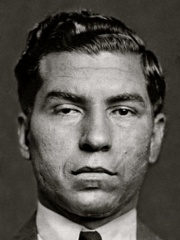
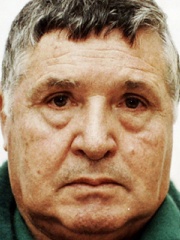

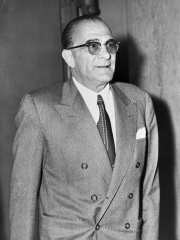
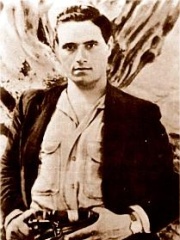
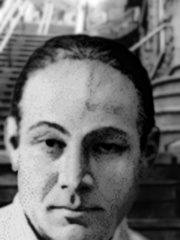
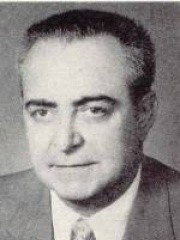
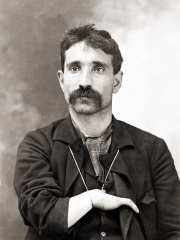
The Most Famous
MAFIOSOS from Italy
Top 10
The following people are considered by Pantheon to be the top 10 most legendary Italian Mafiosos of all time. This list of famous Italian Mafiosos is sorted by HPI (Historical Popularity Index), a metric that aggregates information on a biography's online popularity. Visit the rankings page to view the entire list of Italian Mafiosos.

1. Lucky Luciano (1897 - 1962)
With an HPI of 74.76, Lucky Luciano is the most famous Italian Mafioso. His biography has been translated into 46 different languages on wikipedia.
Charles "Lucky" Luciano ( LOO-chee-AH-noh; Italian: [luˈtʃaːno]; born Salvatore Lucania [salvaˈtoːre lukaˈniːa]; November 24, 1897 – January 26, 1962) was an Italian gangster who operated mainly in the United States. He started his criminal career in the Five Points Gang and was instrumental in the development of the National Crime Syndicate. Luciano is considered the father of the Italian-American Mafia for the establishment of the Commission in 1931, after he abolished the boss of bosses title held by Salvatore Maranzano following the Castellammarese War. He was also the first official boss of the modern Genovese crime family. In 1936, Luciano was tried and convicted for compulsory prostitution and running a prostitution racket after years of investigation by District Attorney Thomas E. Dewey. Although he was sentenced to 30 to 50 years in prison, an agreement was struck with the U.S. Department of the Navy through his Jewish Mob associate, Meyer Lansky, to provide naval intelligence during World War II. In 1946, for his alleged wartime cooperation, Luciano's sentence was commuted on the condition that he be deported to Italy. Luciano died in Italy on January 26, 1962, and his body was permitted to be transported back to the United States for burial.

2. Salvatore Riina (1930 - 2017)
With an HPI of 74.49, Salvatore Riina is the 2nd most famous Italian Mafioso. His biography has been translated into 40 different languages.
Salvatore Riina (16 November 1930 – 17 November 2017), nicknamed Totò, was an Italian mobster and chief of the Sicilian Mafia, known for a ruthless murder campaign that reached a peak in the early 1990s with the assassinations of Antimafia Commission prosecutors Giovanni Falcone and Paolo Borsellino, resulting in widespread public outcry, legal change and a major crackdown by the authorities. He was also known by the nicknames la belva ("the beast") and il capo dei capi (Sicilian: 'u capu di 'i capi, "the boss of bosses"). Riina succeeded Luciano Leggio as head of the Corleonesi criminal organisation in the mid-1970s and achieved dominance through a campaign of violence, which caused police to target his rivals. Riina had been a fugitive since the late 1960s after he was indicted on a murder charge. He was less vulnerable to law enforcement's reaction to his methods, as the policing removed many of the established chiefs who had traditionally sought influence through bribery. In violation of established Mafia codes, Riina advocated the killing of women and children and killed innocent members of the public solely to distract law enforcement agencies. Hitman Giovanni Brusca estimated he murdered between 100 and 200 people on behalf of Riina. Although this scorched-earth policy neutralized any internal threat to Riina's position, he increasingly showed a lack of his earlier guile by bringing his organisation into open confrontation with the state. As part of the Maxi Trial of 1986, Riina was sentenced to life imprisonment in absentia for Mafia association and multiple murders. After 23 years of living as a fugitive, he was captured in 1993, provoking a series of indiscriminate bombings of art galleries and churches by his organisation. His lack of repentance subjected him to the stringent Article 41-bis prison regime until his death on 17 November 2017.

3. Bernardo Provenzano (1933 - 2016)
With an HPI of 69.85, Bernardo Provenzano is the 3rd most famous Italian Mafioso. His biography has been translated into 35 different languages.
Bernardo Provenzano (Italian pronunciation: [berˈnardo provenˈtsaːno]; 31 January 1933 – 13 July 2016) was an Italian mobster and chief of the Sicilian Mafia clan known as the Corleonesi, a Mafia faction that originated in the town of Corleone, and de facto the boss of bosses ("il capo dei capi"). His nickname was Binnu u tratturi (Sicilian for "Bernie the tractor") because, in the words of one informant, "he mows people down". Another nickname was il ragioniere ("the accountant"), due to his apparently subtle and low-key approach to running his crime empire, at least in contrast to some of his more violent predecessors. Provenzano was part of the Corleonesi Mafia clan who backed mob boss Luciano Leggio in the ambush and murder of Michele Navarra in the late 1950s. In 1963, Provenzano became a fugitive after a failed hit. Provenzano also participated in the Viale Lazio massacre in the late 1960s. Salvatore Riina succeeded Leggio in the mid-1970s, and Provenzano became the second-in-command of the Corleonesi. Provenzano took the reins after Riina and Bagarella's arrests, but the three had already been sentenced to life in absentia in the late 1980s as part of the Maxi Trial and in the 1990s for the two high-profile bombings (the Capaci massacre and Via D'Amelio massacre) that killed prosecutors Giovanni Falcone and Paolo Borsellino. After 43 years living as a fugitive, he was captured in 2006, and subjected to the stringent Article 41-bis prison regime until his death on 13 July 2016.

4. Vito Genovese (1897 - 1969)
With an HPI of 67.71, Vito Genovese is the 4th most famous Italian Mafioso. His biography has been translated into 25 different languages.
Vito Genovese (Italian: [ˈviːto dʒenoˈveːze, -eːse]; November 21, 1897 – February 14, 1969) was an Italian-born American mafioso and the leader of the Genovese crime family in New York City. A childhood friend and criminal associate of Lucky Luciano, Genovese took part in the Castellammarese War and helped Luciano shape the Mafia's rise as a major force in organized crime in the United States. He would later lead Luciano's crime family, which was renamed by the FBI after Genovese in 1957. Along with Luciano, Genovese facilitated the expansion of the heroin trade to an international level. He fled to Italy in 1937, and for a brief period during World War II he supported Benito Mussolini's Fascist regime for fear of being deported back to the U.S. to face murder charges. After returning to the U.S. in 1945, Genovese served as mentor to Vincent "Chin" Gigante, the future boss of the Genovese family. In 1957, Genovese vied for the title of capo di tutti capi (boss of bosses) by ordering the murder of Albert Anastasia and the botched hit of Frank Costello. Immediately following this, he called a mafia summit to consolidate his power, but the meeting was raided by police. In 1959, Genovese's reign was cut short as he was convicted on narcotics conspiracy charges and sentenced to fifteen years in prison. While he and his underling Joe Valachi were in prison together, Valachi killed an inmate he thought to be a hitman sent by Genovese. Valachi then became a government witness. Genovese died in prison on February 14, 1969.
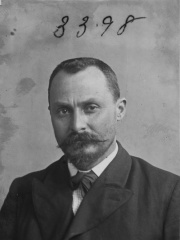
5. Vito Cascio Ferro (1862 - 1943)
With an HPI of 65.32, Vito Cascio Ferro is the 5th most famous Italian Mafioso. His biography has been translated into 16 different languages.
Vito Cascio Ferro or Vito Cascioferro (Italian pronunciation: [ˈviːto ˈkaʃʃo ˈfɛrro]; 22 January 1862 – 20 September 1943), also known as Don Vito, was an Italian criminal who was a prominent member of the Sicilian Mafia. He also operated for several years in the United States. He is often depicted as the "boss of bosses", although such a position does not exist in the loose structure of Cosa Nostra in Sicily. Cascio Ferro's life is full of myth and mystery. He became a legend even when he was alive, and that legend is partially responsible for creating the image of the gallant gentleman capomafia (Mafia boss). He is widely considered to have been responsible for the 1909 murder of Joseph Petrosino, head of the New York City police department's Italian Squad. However, he was never convicted of the crime. With the rise of Fascism in Italy, his untouchable position declined. He was arrested and sentenced to life imprisonment in 1930 and would remain in jail until his death. There is some confusion about the exact year of his death, but according to La Stampa, Cascio Ferro died on 20 September 1943, in the prison on the island of Procida.

6. Salvatore Giuliano (1922 - 1950)
With an HPI of 64.19, Salvatore Giuliano is the 6th most famous Italian Mafioso. His biography has been translated into 19 different languages.
Salvatore Giuliano (Italian: [salvaˈtoːre dʒuˈljaːno]; Sicilian: Turiddu or Sarvaturi Giulianu; 16 November 1922 – 5 July 1950) was a Sicilian brigand, who rose to prominence in the disorder that followed the Allied invasion of Sicily in 1943. In September of that year, Giuliano became an outlaw after shooting and killing a police officer who tried to arrest him for black market food smuggling, at a time when 70 percent of Sicily's food supply was provided by the black market. He maintained a band of subordinates for most of his career. He was a flamboyant, high-profile criminal, attacking the police at least as often as they sought him. In addition, he was a local power-broker in Sicilian politics between 1945 and 1948, including his role as a nominal colonel for the Movement for the Independence of Sicily. He and his band were held legally responsible for the Portella della Ginestra massacre, though there is some doubt about their role in the numerous deaths which occurred. The widespread international press coverage he attracted made him an embarrassment to the Italian government, and throughout his banditry, up to 2,000 police and soldiers were deployed against him. He was murdered on 5 July 1950. The historian Eric Hobsbawm described him as the last of the "people's bandits" (à la Robin Hood) and the first to be covered in real time by modern mass media.

7. Salvatore Maranzano (1886 - 1931)
With an HPI of 62.10, Salvatore Maranzano is the 7th most famous Italian Mafioso. His biography has been translated into 21 different languages.
Salvatore Maranzano (Italian: [salvaˈtoːre maranˈtsaːno]; July 31, 1886 – September 10, 1931), nicknamed Little Caesar, was an Italian-American mobster from the town of Castellammare del Golfo, Sicily, and an early Cosa Nostra boss who led what later would become the Bonanno crime family in New York City. He instigated the Castellammarese War in 1930 to seize control of the American Mafia, winning the war after the murder of rival faction head Joe Masseria in April 1931. He then briefly became the Mafia's capo di tutti capi ("boss of all bosses") and formed the Five Families in New York City but was murdered on September 10, 1931, on the orders of Charles "Lucky" Luciano, who established the Commission, in which families shared power to prevent future turf wars.

8. Russell Bufalino (1903 - 1994)
With an HPI of 61.46, Russell Bufalino is the 8th most famous Italian Mafioso. His biography has been translated into 17 different languages.
Russell Alfred Bufalino (; born Rosario Alfredo Bufalino, Italian: [roˈzaːrjo alˈfreːdo bufaˈliːno]; October 29, 1903 – February 25, 1994) was an Italian-American mobster who became the crime boss of the Northeastern Pennsylvania Italian-American Mafia crime family known as the Bufalino crime family, which he ruled from 1959 to 1994. He was a cousin of attorney William Bufalino, the longtime counsel for Jimmy Hoffa.

9. Giuseppe Morello (1867 - 1930)
With an HPI of 60.12, Giuseppe Morello is the 9th most famous Italian Mafioso. His biography has been translated into 15 different languages.
Giuseppe "the Clutch Hand" Morello (Italian: [dʒuˈzɛppe moˈrɛllo]; May 2, 1867 – August 15, 1930), also known as "the Old Fox", was the first boss of the Morello crime family and later top adviser to Giuseppe "Joe the Boss" Masseria. He was known as Piddu (Sicilian diminutive form of Giuseppe) and his rivals the Castellammarese knew him as Peter Morello. He had a deformed right hand with only one finger, resembling a claw. In the 1890s, Giuseppe founded a gang known as the 107th Street Mob, which would later evolve into the Morello crime family. Today the Morello crime family is known as the Genovese crime family and is the oldest of the Five Families in New York City.
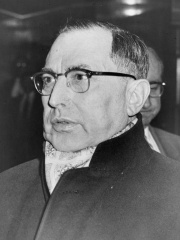
10. Joe Profaci (1897 - 1962)
With an HPI of 57.81, Joe Profaci is the 10th most famous Italian Mafioso. His biography has been translated into 16 different languages.
Giuseppe "Joe" Profaci (Italian: [dʒuˈzɛppe proˈfaːtʃi]; October 2, 1897 – June 6, 1962) was an Italian-American Cosa Nostra boss who was the founder of what became the Colombo crime family of New York City. Established in 1928, this was the last of the Five Families to be organized. He was the family's boss for over three decades.
People
Pantheon has 11 people classified as Italian mafiosos born between 1862 and 1933. Of these 11, 1 (9.09%) of them are still alive today. The most famous living Italian mafiosos include Peggy Hettrick murder case. The most famous deceased Italian mafiosos include Lucky Luciano, Salvatore Riina, and Bernardo Provenzano.
Living Italian Mafiosos
Go to all RankingsDeceased Italian Mafiosos
Go to all RankingsLucky Luciano
1897 - 1962
HPI: 74.76
Salvatore Riina
1930 - 2017
HPI: 74.49
Bernardo Provenzano
1933 - 2016
HPI: 69.85
Vito Genovese
1897 - 1969
HPI: 67.71
Vito Cascio Ferro
1862 - 1943
HPI: 65.32
Salvatore Giuliano
1922 - 1950
HPI: 64.19
Salvatore Maranzano
1886 - 1931
HPI: 62.10
Russell Bufalino
1903 - 1994
HPI: 61.46
Giuseppe Morello
1867 - 1930
HPI: 60.12
Joe Profaci
1897 - 1962
HPI: 57.81
Overlapping Lives
Which Mafiosos were alive at the same time? This visualization shows the lifespans of the 10 most globally memorable Mafiosos since 1700.


